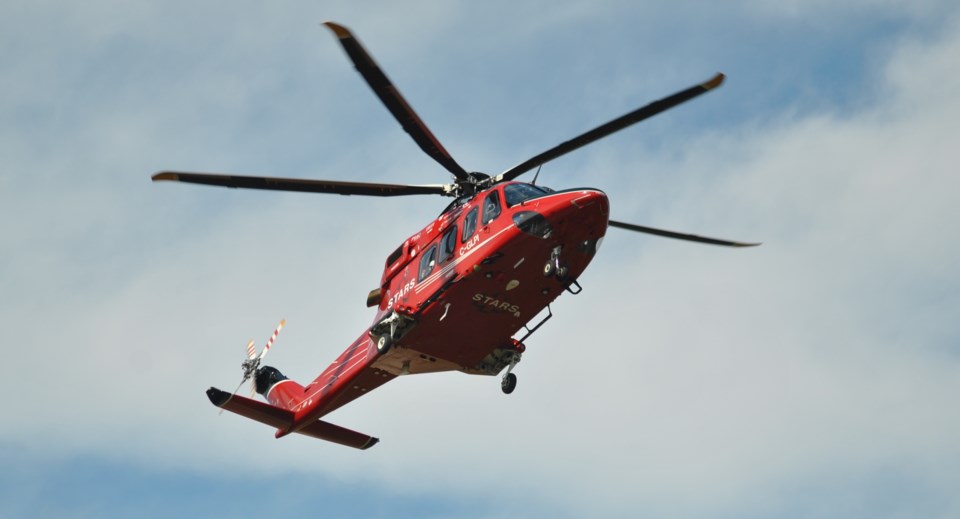The coronavirus has impacted the bottom lines of thousands of Albertans and STARS Air Ambulance is no different.
STARS is a non-profit society that provides air ambulance service to critically-ill patients.
"COVID-19 has changed all our lives," municipal relations liaison Glenda Farnden told County of Barrhead councillors.
To protect its patients and staff from potentially contracting or passing on the virus STARS crews have developed enhanced personal equipment (PPE) and decontamination procedures.
Farnden appeared before councillors via video conference during their Dec. 15 meeting to thank the municipality for being a long time supporter of STARS, contributing at the $1 per capita level, as well as ask them to commit to continuing to do so at least until 2023.
Later in the meeting council informed her that STARS is one of the groups that has been preselected to be included in their annual budget deliberations automatically.
Farnden said dealing with COVID has been difficult on two fronts, medically and financially.
To deal with the medical dangers of the virus, STARS has enhanced its personal protective equipment (PPE) and disinfection protocols.
STARS transport physicians have also developed an online portal for medical personnel, developed enhanced airway management protocols as well as oxygenation and ventilation procedures.
The organization's expertise is one of the reasons they were invited to take part in an international consortium to share information about the virus, Farnden said.
"These are stressful times and we continue to see stress-related missions, like heart attacks, stroke and drug overdoses," she said.
As the number of coronavirus infections has increased across Western Canada, so has the volume of COVID responses. STARS estimates that about 13 to 18 per cent of call volumes are the result of suspected or confirmed COVID cases.
Unfortunately, in addition to the added medical concerns the virus is having on the organization, COVID has severely impacted its bottom line.
The 10-year agreement with the provincial government and Alberta Health Services (AHS) that provided about 20 per cent of its operating budget has expired. In 2019, STARS received $9.2 million, in 2020 that amount dropped to roughly $7.3 million.
Farnden said after the recent helicopter emergency medical services (HEMS) review, AHS has extended its agreement with STARS until September 2021.
"STARS fundraising initiatives have all decreased. The 2020 lottery did not sellout, accounting for $1.2 million in lost revenue," she said, adding the pandemic has also meant that they have had to cancel the vast majority of its other fundraisers, nor is it likely they will be able to resume in the foreseeable future.
At the same time that their revenue is decreasing, the demand for services is increasing, with the number of missions STARS flys going up steadily.
In the Barrhead region, STARS has flown 10 missions so far this year, including two missions just the previous week. A number Farnden, suspects will increase. She said not only are they in the middle of what is traditionally one of their busier times of the year, but STARS is being called upon to do more inter-facility transfers due to the pandemic.
Despite their best efforts, Farnden said STARS has been forced to layoff people at all of its bases.
She also noted STARS is in the middle of a large capital project, replacing their aging fleet of BK117 units, which have been in service for 35 years and bring in nine new H145 helicopters. The total cost of the project was $117 million but STARS received a $65-million federal grant that covered five units, and the Government of Saskatchewan paid for a machine in Saskatoon with AHS footing the bill for one Alberta unit. In the end, STARS was left to fund two of its nine new helicopters, at an estimated cost of $30 million. However, they hope to reduce that number by half by offsetting the costs with the sale of its current fleet. In addition to the capital costs, the new helicopters require crews to learn new procedures which means added training costs, at least initially.
"Which is why we are truly grateful to our municipal partners like the County of Barrhead," Farnden said. "You represent one area of STARS support that is unwavering. You continue to be a lifeline for STARS."
Reeve Doug Drozd asked how the pandemic would impact the upcoming STARS lottery slated to launch in January. He noted that a lot of the draw of the lottery was the exotic trips people could win.
"Going forward the lottery will be more vital than ever. It is our largest, single funding source," Farnden said. "We are trying to be innovative. We have a new team and they are trying to think outside the box, looking at different options to get away from the trips that are more conducive to the times we are living in."
Barry Kerton, TownandCountryToday.com


